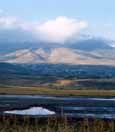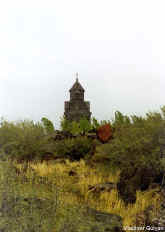|

|
Bear
leftish toward Aparan and continue 5.5 km to an unsignposted asphalt
road to the right, which leads across the valley to the village of Buzhakan
(once Babakishi) and the splendid ruined Teghenyats
monastery
in a forested fold of the Tsakhkunyats mountain
range. Set
between two |
|
Hrazdan Gorge is impressive
primarily for its Paleolithic-looking rock formations, and for the
Paleolithic
persons who inhabited them, leaving
along the river bank ample worked stone traces of their
presence. The drive is
a pleasant alternative
to the main Sevan highway,
slower of course, but over a
generally
|

|
|
streams, with a distant view of Mt. Ararat, the
site has sheep and horse-shaped tombstones, an impressive half-intact
gavit (narthex) beside the ruined sanctuary (12th century),
parts of a monumental dining room (13th c.), and lots of
atmosphere. The road to the monastery dubiously passable, allegedly goes on to
Tsakhkadzor. There
are walking/mountain bike trails and picnic ambiance. The final bit of road is not recommended for street cars (except
someone else’s). On the E side of the village of Buzhakan is a 6th-7th
century ruined
church.
|
|
decent asphalt road. The
first village N of Yerevan is Arinj,
with remains of a medieval fort nearby, with
dragon carving of 1501 on
lintel and eagle commemorating Bishop Hovhannes and remains of
Astvatsatsin church. New built
Astvatsatsin church and a Hellenistic period
settlement are nearby. E of the village is
Dzagavank
or Getargeli S. Nshan, with a ruined 7th c. church (S. Nshan)
and a formerly two-story 13th c. church E of it.
|